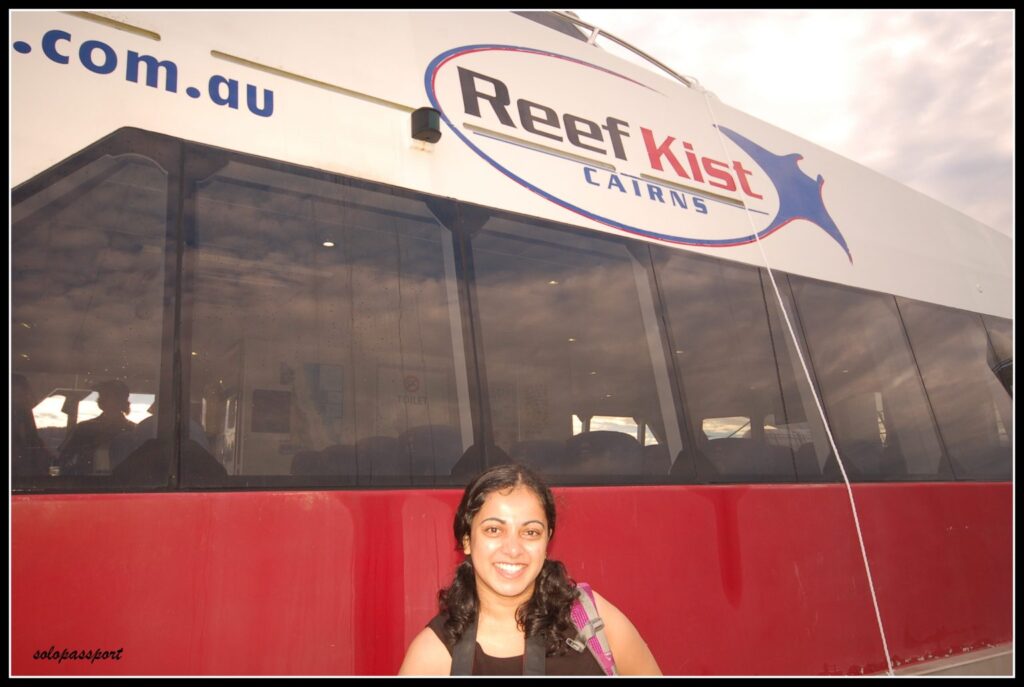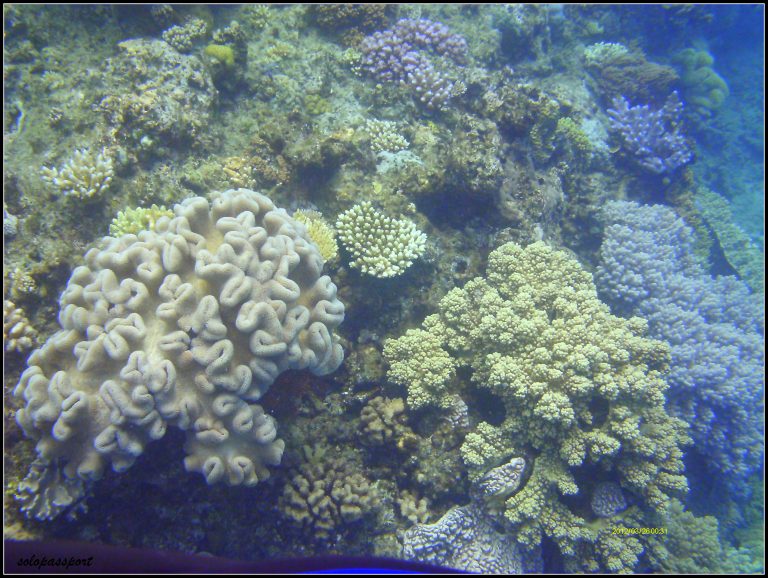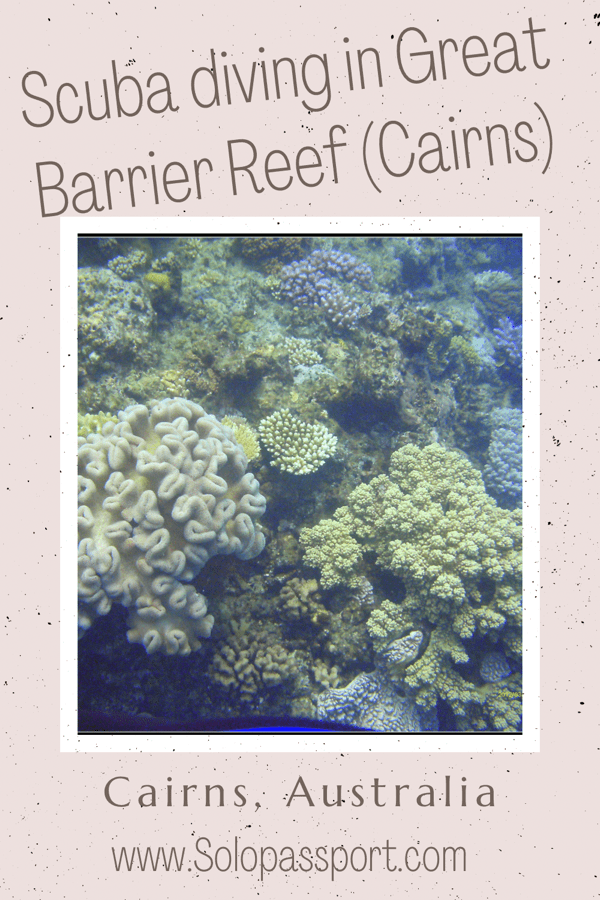Scuba Diving at Great Barrier Reef in Cairns (2024)
Who would not want to dive in the Great Barrier Reef? It is the largest living creature in this world, that is visible from space and diving in that Great Barrier Reef is on every scuba diver’s bucket list visiting Australia. Similarly, I had scuba diving in Great Barrier Reef on my list from the time I stepped my foot in Australia. It was a dream for me, which came true when I went scuba diving at Great Barrier Reef a few years ago, and that was before I received my PADI certifications.
From my first dive at Great Barrier Reef, I have in time gone back diving multiple times. Even after my Rescue Certification, I have done a few recreation dives at Great Barrier Reef in Cairns.
Page Contents
PIN for later reference

This article may contain affiliate links, meaning if you decide to purchase via my links, I may earn a commission at no additional cost to you. For complete information, please see our affiliate disclaimer here.
Disclaimers:
- The prices mentioned in the post are valid only at the time of publication. Ensure that you check the booking websites for up-to-date information and prices.
- My opinions and views are unbiased. If the post is a collaboration, then they are specifically mentioned.
- Ensure that you check the relevant websites for up-to-date information on COVID protocols.
- For any adventurous activities, please note that there is a risk that can be dangerous. Ensure you read the terms and conditions recommended by individual agencies and do them at your own risk.
- For visas, it is best to see the embassy website for changing rules.
- While using the recommended guides, auto-drivers or taxi drivers, do your due diligence and trust your judgement.
About Great Barrier Reef
The Great Barrier Reef is the world’s largest living structure with about 3000 individual coral reefs and 900 islands. It stretches over 2300 kilometres and is on the North-Eastern side of Australia, off the coast of Queensland. Located off the coast of Queensland state in Australia, the Great Barrier Reef is one of the most complex ecosystems in the world. It has a vast range of ecological communities, species and habitats and is around 500,000 years old. And did you know that Great Barrier Reef is estimated as an asset value of AUD 56 billion?
Note: After diving in both Cairns and Port Douglas, I recommend diving in Port Douglas. The dive sites in Port Douglas are less crowded and are absolutely amazing. They are way better than the dive centres at Cairns.
Discover Scuba Diving at Great Barrier Reef (My First Dive)
Few days before the dive
A long weekend of Australia Day was coming up and I had to travel somewhere. But where? I decided to go with my long-pending bucket list item, a scuba dive in the Great Barrier Reef. As Cairns is the gateway to the Great Barrier Reef, I planned a travel to Cairns. As I was traveling solo, I made sure my itinerary was very well planned with all the activities booked.
As the day of the dive approached, I had mixed feelings of being excited, pumped, scared, and nervous. Suddenly out of nowhere, there were news every day about the shark sightings and attacks (well, a shark had attacked a dolphin) along the coast of New South Wales. As I was already nervous, the newspapers were not helping me either. So, I decided to research on the sharks that live in the Great Barrier Reef (Why not, isn’t it better to be mentally prepared?).
I learned that the most common ones in Great Barrier Reef are reef tip (I actually spotted one, during my submarine tour that I had taken the previous day) and Hammerhead sharks. The reef tip sharks are quite timid and harmless, and Hammerhead sharks are not overly aggressive, but then there are the tiger sharks which are said to be aggressive. I further did some statistical analysis and assured myself that I am safe based on the number of attacks that have happened in the past. There is a famous saying “You are most likely to be hit by a bus than be bitten by a shark“.
On the day of the dive
I had hardly slept the previous night and was super excited about my dive. It had finally arrived, after so many months of planning and here I was ticking off one of my bucket list items in just a few hours. I started my day at 6 AM, decided to have a morning stroll from Youth Hostel Association (YHA) Cairns to the Jetty. The boat was picking me up from the Jetty and driving to the dive sites, somewhere in the middle of Great Barrier Reef.
Cairns Dive Centre
[12-12-2022] !!! Unfortunately, Cairns Dive Centre is permanently closed.
After plenty of research on the scuba dive centers (reason for the ‘plenty’ of research was because of the bad dive experience I had in Gold Coast), I finalized with Visit Cairns and they in turn booked my dive with the Cairns Dive Centre (CDC). CDC have been operating for over 30 years and have dived at various dive sites in Cairns and Fitzroy island. The entire booking process with them was very smooth and easy.
The one day dive tour with CDC that included one introductory dive, the boat charges, reef levy, instructor, scuba diving equipment and lunch cost around AUD 170.
My first dive experience at Great Barrier Reef
The dive tour started early morning at around 7 AM and it was scheduled for an entire day. I was welcomed by the CDC staff and they clicked a picture of mine in front of the boat.

After our medical declarations and a light refreshment of tea and coffee, we reached the place where we were diving. Initially, we were given instructions for snorkeling. As I am not a swimmer, one of the friendly staff was with me at all times in the water. Due to the clarity of the water, the fishes, corals and its beautiful colors were visible even while snorkeling (you don’t need to dive in order see the corals and the fishes in the Great Barrier Reef).
After an hour of snorkeling, I was called out for the scuba dive. We were two of us doing the Intro/Discover scuba dives. We were asked to wear all the scuba diving gear, including a wet suit, weights, mask, and fins and were briefed with the safety instructions. One instructor accompanied the two us, who was holding one of our hands throughout the dive. Initially, the water had seeped into the mask and my eyes were burning but that was due to the hair strand that was in between the mask. With the help from my instructor, I was all sorted and was ready to go down even deeper into the ocean. The descent of 10 metres was very gradual that helped me in equalising.

Once I was down at 10 metres, I started to look around and observe the spectacular busy life around me in that big blue world. There were so many different kinds of fishes, that were of different sizes and colours. The big, small, funny nosed, yellow, white, purple, green, blue colored fishes and many more. And they seemed to be all around us. Some peeped from the corals and others just swam close to us.

Highlight of my dive was the clown fish that I spotted during my dive. The clown fish is popularly known as ‘Nemo’ from the movie Finding Nemo. Other than the fishes, there were corals that were so beautiful and colorful. Corals are mainly classified as soft corals and hard corals. Again, these were in all shapes and sizes. And I saw them all.
The entire experience of seeing the largest living structure on earth was so mystical, special and extraordinary.

Recreational Dives at Great Barrier Reef
As I mentioned earlier, after completing my PADI certifications, I went back to Great Barrier Reef for recreational diving. This time around as I was confident, I had an amazing time during the dives. I saw a turtle, many clown fishes, and plenty of other marine life. It was absolutely mesmerising. You can expect to see sharks, turtles, Nemos (clown fishes), Barracudas, Groupers and many more. I did three dives this time around and all three were absolutely brilliant with at least 20 metres visibility.
It is best to book in advance as it is usually very crowded at all times.
Quicksilver Group
I went back to Cairns to dive after I received my certifications and I dived with Quicksilver Group. I opted for recreation diving as I did not need an instructor due to my certification.
They have Discover Scuba Diving in a pool before the divers are taken into the ocean. The pool session takes around 45 minutes and cost AUD 115 per person. This is then followed by a scuba dive in the open water at any of the dive sites (Note this cost extra).
Safety for solo female divers
It is best to go diving with a dive centre as they take care of all the safety aspects. If this is the first time you are diving, ensure to go with a reputed dive centre. Also, even the most experienced divers, go with a dive buddy or other experienced divers.
Closing Notes
Scuba diving in Great Barrier Reef is a must-do when you are traveling in Australia and your Australian travel is for incomplete without a dive or at least a snorkel in the Great Barrier Reef. I am so glad that I went ahead and did the dive, and ticked off the item on my bucket list. Having dived in both Cairns and Port Douglas, I suggest doing the dive in Port Douglas as it is less commercialised.
How can you support me?
You know how much I love coffee, so you can buy me a coffee – Buy me Coffee!
Or you can purchase from one of the below travel resources without any extra charge to you:
Travel Resources
Book your flight on Skyscanner.com or Trip.com
Reserve your accommodation on Stay22
Reserve your stay at a hostel on HostelWorld
Use RentalCars or DiscoverCars for hiring self-driven cars
Book your tours and travels or purchase tickets on Viator or GetYourGuide
For a universal SIM card, use DrimSim
Buy comprehensive travel insurance on SafetyWing and WorldNomads
If you liked this article and if it was helpful in your planning or travelling, do share, tweet, or pin this post.
Follow me on Instagram | Facebook | YouTube | Twitter | LinkedIn
Do you have a question? Do you want any suggestions and tips for travel, hikes, and scuba dives? Use the Subscription box below to sign up and get updates by email.
PIN for later reference

